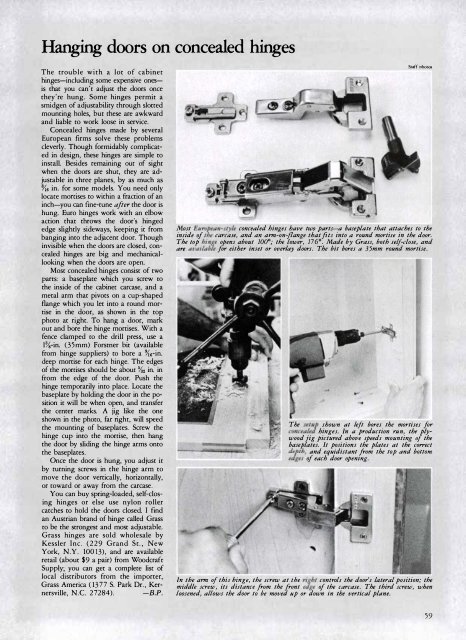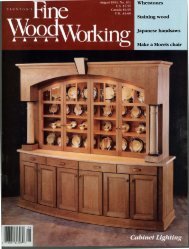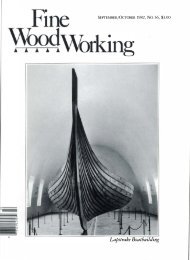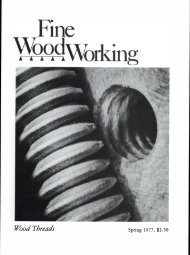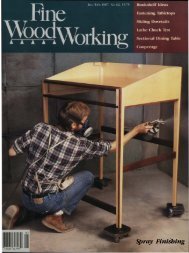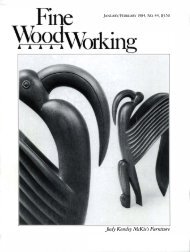NOVEMBER/DECEMBER 1983, No. 43, $3.50 Making ... - Wood Tools
NOVEMBER/DECEMBER 1983, No. 43, $3.50 Making ... - Wood Tools
NOVEMBER/DECEMBER 1983, No. 43, $3.50 Making ... - Wood Tools
You also want an ePaper? Increase the reach of your titles
YUMPU automatically turns print PDFs into web optimized ePapers that Google loves.
Hanging doors on concealed hinges<br />
The trouble with a lot of cabinet<br />
hinges-including some expensive onesis<br />
that you can't adjust the doors once<br />
they're hung. Some hinges permit a<br />
smidgen of adjustability through slotted<br />
mounting holes, but these are awkward<br />
and liable to work loose in service.<br />
Concealed hinges made by several<br />
European firms solve these problems<br />
cleverly. Though formidably complicated<br />
in design,<br />
can<br />
these hinges are simple to<br />
install. Besides remaining Out of sight<br />
when the doors are shut, they are adjustable<br />
in three planes, by as much as<br />
7i6 in. for some models. You need only<br />
locate mottises to within a fraction of an<br />
inch-you fine-tune after the door is<br />
hung. Euro hinges work with an elbow<br />
action that throws the door's hinged<br />
edge slightly sideways, keeping it from<br />
banging into the adjacent door. Though<br />
invisible when the doors are closed, concealed<br />
hinges are big and mechanicallooking<br />
when the doors are open.<br />
Most concealed hinges consist of twO<br />
patts: a baseplate which you screw to<br />
the inside of the cabinet carcase, and a<br />
metal arm that pivots on a cup-shaped<br />
flange which you let into a round mortise<br />
in the door, as shown in the top<br />
photo at right. To hang a door, mark<br />
out and bore the hinge mortises. With a<br />
fence clamped to the drill press, use a<br />
lo/s-in. (35mm) Forstner bit (available<br />
from hinge suppliers) to bore a �6-in.<br />
deep mortise for each hinge. The edges<br />
of the mortises should be about %2 in. in<br />
from the edge of the door. Push the<br />
hinge temporarily into place. Locate the<br />
baseplate by holding the door in the position<br />
it will be when open, and transfer<br />
the center marks. A jig like the one<br />
shown in the photo, far right, will speed<br />
the mounting of baseplates. Screw the<br />
hinge cup into the mortise, then hang<br />
the door by sliding the hinge arms onto<br />
the baseplates.<br />
Once the door is hung, you adjust it<br />
by turning screws in the hinge arm to<br />
move the door vertically, horizontally,<br />
or toward or away from the carcase.<br />
You can buy spring-loaded, self-closing<br />
hinges or else use nylon roller<br />
catches to hold the doors closed. I find<br />
an Austrian brand of hinge called Grass<br />
to be the strongest and most adjustable.<br />
Grass hinges are sold wholesale by<br />
Kessler Inc. (229 Grand St., New<br />
York, N.Y. 100 13), and are available<br />
retail (about $9 a pair) from <strong>Wood</strong>craft<br />
Supply; you can get a complete list of<br />
local distributors from the importer,<br />
Grass America (1377 S. Park Dr., Kernersville,<br />
N.C. 27284). -B.P.<br />
Scaff photos<br />
Most European-style concealed hinges have two parts-a baseplate that attaches to the<br />
inside of the carcase, and an arm-on-flange that fits into a round mortise in the door.<br />
The top hinge opens about 100°; the lower, 1760• Made by Grass, both self-close, and<br />
are available for either inset or overlay doors. The bit bores a 35mm round mortise.<br />
...<br />
The setup shown at left bores the mortises for<br />
concealed hinges. In a production run, the/lywood<br />
jig pictured above speeds mounting 0 the<br />
baseplates. It positions the plates at the correct<br />
depth, and equidistant from the top and bottom<br />
edges of each door opening.<br />
In the arm of this hinge, the screw at the right controls the door's lateral position; the<br />
middle screw, its distance from the front edge of the carcase. The third screw, when<br />
loosened, allows the door to be moved up or down in the vertical plane.<br />
59


